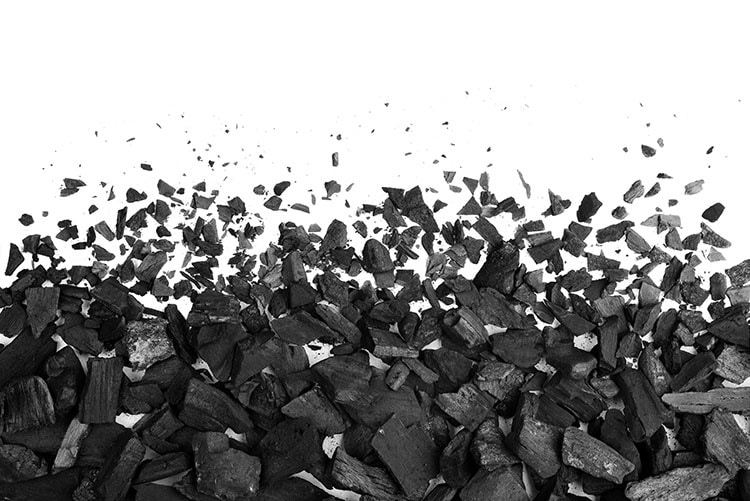By Chloe Klusman, Zoe Gunter, and Dr. Heather Broadhead
Activated carbon (AC) has been utilized in several biomedical applications such as wound care and hemoperfusion, and in this work, experimental procedures were designed and carried out to better understand the effect of AC on bacteria, viruses, and parasites.
Antimicrobial properties of AC are relevant to the coatings industry because they can be incorporated into gel, liquid, or other coatings to impart antipathogenic properties. Possible biomedical applications include gels used for catheter tubing, drug capsule shells, and medical implants.
These experiments analyzed the ability of various sources of AC to exhibit antimicrobial properties by prohibiting the growth and propagation of pathogens. Wood, coconut, and coal-based AC were evaluated for activity against a series of bacterial dilutions with Escherichia coli (E. coli) and Staph aureus (S. aureus), a series of viral dilutions with T1 and Φ11 bacteriophages, and a series of parasitic dilutions with Euglena gracilis. Results were compared and analyzed using microscopy and other standard plating techniques.
Overall, the results collected from various trials displayed a significant reduction in the activity of the pathogens. Now that the concentration requirements and responsivity for the different pathogens are known, the potential mechanisms of interaction can be investigated.
In the presence of AC, the Euglena gracilis were observed to become immobile upon contact with AC. Unable to remain mobile, the Euglena expired. The immobilization of the parasite suggests that adsorption may play a key role in antipathogenic activity, although more studies are needed to be conclusive. Further research will be conducted to use AC in new biomedical applications, which will serve not only the biomedical industry but other research areas as well.
INTRODUCTION
Activated carbon has been used in biomedical research for decades due to both its adsorptive qualities and the ease of its production. AC is most commonly generated through heterogeneous reactions that increase surface area and create highly porous structures. Many claim that the increased porosity is key to providing antimicrobial properties as their capacity for adsorption increases.1 Accordingly, the chemical production process determines the chemical and physical characteristics, which ultimately provides the adsorptive properties of activated carbon.
AC can also be chemically tailored, as demonstrated in a study where chemical activation of olive-stone derived AC with phosphoric acid was achieved during the production process.2 The phosphoric acid functionalized AC is significant because the activation of AC through chemical reactions can alter the compound’s surface chemistry and thus its performance. In addition, through this activation, the micropore, mesopore, and the narrow micropore volumes were determined as well as the apparent surface area and the pore size distribution.2 The extent to which the chemical activation affects these physical properties remains unknown.
The identification and utilization of the antimicrobial properties of AC is relevant to several commercial applications, as its adsorption capacity and cost-effectiveness could provide an alternative to more expensive antimicrobial products. Activated carbon is designated as GRAS (generally recognized as safe) by the FDA in some forms such as medical-grade, coconut-shell-based AC, and as such it has the potential to be quickly implemented as an antimicrobial alternative in biomedical applications.
The use of AC as an antimicrobial agent has long been of interest to researchers, as several peer-reviewed studies explore its ability to inhibit the propagation of bacteria. For example, a study performed in 2001 examined the adsorption of enterohemorrhagic E. coli through its exposure to AC.3 The results for the study were promising, as the propagation of the bacteria and its toxins were limited or inhibited by the presence of the AC (with better results shown at higher concentrations of AC exposure4).
CONTINUE READING IN THE SEPTEMBER 2021 DIGITAL ISSUE OF COATINGSTECH
REFERENCES
- Lozano-Castello, D.; Cazorla-Amoros, D.; Linares-Solano, A.; Quinn, D. F. Activated Carbon Monoliths for Methane Storage: Influence of Binder. Elsevier 2002, 40 (15), 2817–2825.
- Ruiz-Rosas, R.; García-Mateos, F. J.; Gutiérrez, M. del; Rodríguez-Mirasol, J.; Cordero, T. About the Role of Porosity and Surface Chemistry of Phosphorus-Containing Activated Carbons in the Removal of Micropollutants. Frontiers in Materials 2019, 6.
- Naka, K.; Watarai, S.; Tana; Inoue, K.; Kodama, Y.; Oguma, K.; Yasuda, T.; Kodama, H. Adsorption Effect of Activated Charcoal on Enterohemorrhagic Escherichia Coli. Journal of Veterinary Medical Science 2001, 63 (3), 281–285.
- Thambiliyagodage, C.; Mirihana, S.; Gunathilaka ,
H. Porous Carbon Materials in Biomedical Applications. Biomedical Journal of Scientific & Technical Research 2019, 22 (4), 16905–16907. - Thomas, B. N.; George, S. C. Production of Activated Carbon from Natural Sources. iMedPub Journals 2015,
1 (1), 1–5.
CoatingsTech | Vol. 18, No. 9 | September 2021
